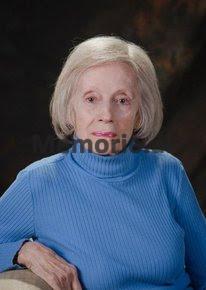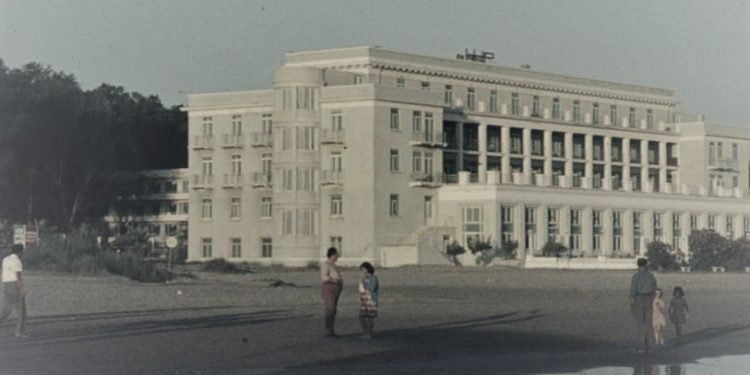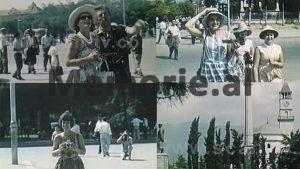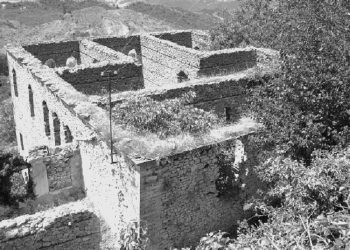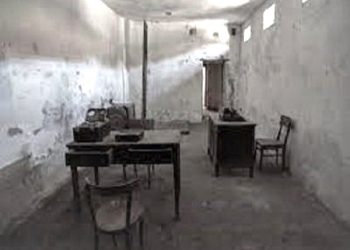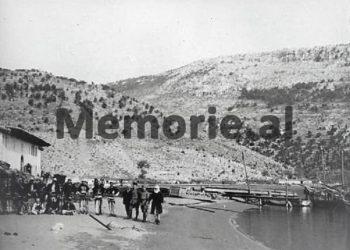By Marvin Howe
Memorie.al / For many years I wanted to visit Albania, the land of the eagle, known for its descent from ancient Illyria and which has consumed its history, fighting against foreign invaders. But Albania (name given by the journalist, – ed.), known as Albania, has been the most controlled and isolated country in Europe. Led by the Stalinist leader, Enver Hoxha, for 40 years, Albania turned its back on the USA, the Soviet Union and China, preferring to go it alone.
Until recently, the People’s Socialist Republic of Albania was almost closed to Americans, with the carefully selected exception of Albanian-Americans. But now, President Ramiz Alia, who took over after Mr. Hoxha’s death in 1985, has begun to open the gates to foreign tourists in a limited manner. Approximately, 100 thousand foreign citizens visited Albania this year, where only a handful of them are Americans.
At the end of October, I joined a Greek group organized in Athens, for a six-day tour of Albania. In general, our impressions of the communist state of the Balkans, which stretched along the Adriatic, were different. There was a rugged, rugged charm to the mountain country, which was smaller than Maryland and had a population of just 3 million. Albania, which lies between Yugoslavia in the North and Greece in the South, was recognized worldwide in 1950.
The isolated Albanian society seemed to have escaped modern diseases such as: drug use, alcohol, violent crime, AIDS and car overcrowding. It was practically an environmental paradise, with generally unpolluted air, clean parks, beaches and nature, as well as fresh food. The state guaranteed housing for citizens, free health care, education and cultural opportunities.
But these advantages had a cost (tribute): the total removal of freedom of speech and movement; outlawing all religious beliefs and prohibiting their practice; the disappearance of private property, including the use of personal cars. The security (said by the author with this name, – note ed.) or the secret police, was everywhere and anyone who made just one sign could be punished up to 3 years in prison.
Throughout our time and contacts, we were controlled and the further we went, we were surprised how Albania seemed to escape from the whirlwind of changes that engulfed most of the Southeast European countries. I learned about the tour from the Greek representative of “Albturist”, the official State Tourist Agency.
We were a group of 22 people, most of whom were Greek, two Greek-Australians, one Greek-American. Some members of the group had been in Albania before, and were going to meet their relatives, since about 200 thousand ethnic Greeks lived in the South of Albania (given that the journalist may have received it from fellow travelers, Greek citizens , – note ed.), but most of us were curious to learn about the life of the last Stalinist state in Europe.
It was an Indian sparkling wine in Greece, which has its merits. Our journey, 320 kilometers north towards the Albanian border, was followed by the wonderful island of Corfu. Then we passed through the hilly area with lakes in Ioannina, towards the Greek border and finally to Kakavija. Before anyone had crossed the border yet, our cheerful bus driver, Kostas Mantalas, who had picked up more than 40 excursionists to take them to Albania, briefly explained to us what we had to do: We had to declare foreign currencies and anything of value, such as; watches, jewelery and cameras.
Kostas warned that the main thing was not to have pornographic or even religious materials. Also, not to be photographed at the border, because it was a military zone. Indeed, the border looked like a military camp, with a barbed wire fence and small bunkers, all on the hills. Albanian officials, humanely, invited us to take out the luggage for inspection, pointing out that all gifts to Albanians must be declared and customs taxes paid.
We met two Albanian tour guides at the border, who introduced themselves as Spiro and Eleftheria; they spoke Greek but no English, but my Greek companions would serve as interpreters. As we drove through the southern corner of Albania, the road passed through bleak mountains. There was no traffic, except for the occasional passer-by; some transported goods by donkey or oxen-drawn carts.
“In general, this space was deserted during the Second World War, but now all the provinces have water and electricity”, said Spiro, pointing to the “Joseph Stalin” hydropower plant. Our first destination was Saranda, known as the pearl of the Albanian Riviera. From a distance, the city looked like an amphitheatre, surrounded by palm trees. The main difference was that here, there were no private cars. We met a group of French tourists who had been swimming and enjoying the clear water and mild temperature.
We stayed at the “Butrinti” hotel, which was the best in the city. My room was clean. There was plenty of warm water, but no curtains; the bathroom mechanisms did not always work, while the toilet paper was rough; the bed was foldable, and there was no radio or television. But I had a balcony in my room, overlooking the island, with a curtain on its outer door.
When I went for a walk along the shore, I saw only a group of men and boys, doing their nightly ritual, on the promenade that had a central cafe. The lights were dim and the lack of cars in the city created an eerie feeling.
“We expect Greek, Italian, French, German tourists, but not Russians and Americans,” said a saleswoman in the main bookstore, who looked at the American tourist with curiosity and disbelief. There are no magazines or newspapers in foreign languages here, but only Enver Hoxha’s memoirs, in English and French. In the lobby of the hotel, some Albanians were talking with relatives-visitors coming from abroad, but they were not allowed to stay inside the tourist hotel or to have lunch or dinner with the tourists in its premises.
Lunch, like all meals, was a group affair, as it was controlled by two Albanian attendants. There was no alternative menu, but the food tasted good and was the same or similar to Greek cuisine. From the first night we had chicken, meat and vegetable soup, as well as cream (pudding) for dessert. Drinks were separate but not expensive. A bottle of red “Merlot” and a bottle of “Glina” mineral water were displayed in the bar, costing 15 Lek, about $2.
For evening entertainment there was a night club, where there was an energetic orchestra, which entertained groups of tourists with traditional Albanian and Greek music. The next day, after a breakfast of omelette, bread, fresh honey and a very fine coffee, we took a short trip to Saranda. The grocery stores seemed filled with goods grown in the area, such as: cabbage, leeks, peppers, tomatoes, oranges, tangerines and apples, but no imported produce.
In the daily market, milk was retail, from which a white cheese was produced. There was no butcher, but I learned from the locals that meat was ration, generally, about 2 pounds per family, every two weeks. According to local residents, cattle were the only thing they had and that was an opportunity for their export.
Leaving Saranda, we travel inland, along the western ridge, – “the only swamp open before 1944”, – says Spiro. Now the valley of the Drino River produced more wheat, rice, wheat and grazed sheep. I saw small agricultural machines and only one woman working in the field, plowing with a hoe. Above the valley, like a fairytale kingdom, lay Gjirokastra, which gave the impression of a silver castle.
Stone city
The birthplace of Enver Hoxha and the best contemporary writer, Ismail Kadare, Gjirokastra, was declared a cultural monument. The house of Mr. Hoxha is now the National Liberation War Museum. From the fortress on top of the mountain, the medieval town, with its narrow cobbled streets and stone houses with flat tiles, looked like silver. The fort is now the National Armaments Museum, displaying early silver, gold-plated rifles and daggers, weapons recovered from the Germans and Italians in World War II, and a United States Air Force spy plane that had fell in 1950. When dusk fell, traffic in the city became terribly dangerous. There were only a few carts and bicycles, all without light bulbs, but there were many pedestrians, sheep, cats, donkeys and chickens. In fact, Kosta seemed a little demoralized, so much so that he could barely be seen among the turkeys’ feathers.
The journey to the capital
At the end of a very long day, we arrived in Tirana, the capital with 250,000 inhabitants and sparkling lights along the promenades. At the time we had arrived, only one road axis was filled with pedestrians, while the others with buses with pickup trucks. We stayed at Hotel Tirana, the only tall building in the city, from where we could see the wide “Skënderbej” square, where the giant statue of Mr. Hoxha.
The hotel, which had the National Historical Museum on one side and the Palace of Culture on the other, was overcrowded with foreign visitors, mostly Germans. I met two Albanian-American women, one from Massachusetts and the other from Florida, who had come to visit their relatives. They had applied for a visa a year ago, through the Mission of Albania in Italy, and said they were happy with their two-week tour.
In the morning I went out to see the city. There were modern but monotonous apartment buildings, namely charmless, poorly used apartment blocks. People who looked generally relaxed were dressed in brightly colored sweaters and trendy pants and tops. In meeting strangers, they were a little shy, but friendly.
The monumental space around the hotel was impressive. The beautiful 19th century mosque of Et’hem Beu is now a museum. 1830 City Clock; the equestrian statue of Skanderbeg, the national hero of the 15th century; the statues of Stalin, Lenin, Hoxha and his museum.
We visited the National Historical Museum, a pleasant, modern building with exhibits ranging from the life of the early Illyrians to the archives of the Communist leadership of the proletariat. But we could not visit another 170 museums of the city.
Towards the coastal area
Later, we traveled around 25 miles to Durrës, the country’s main port and coastal assets. Durrës is the early city of Epidamnos, founded as early as 627 BC and its Archaeological Museum contained some beautiful Greek and Roman statues. Behind it is an amphitheater built in the second century BC and holding 15,000 people and a small shrine of St. Stephen, with some beautiful mosaics.
We had lunch at the “Adriatiku” hotel, one of the six largest hotels in Durrës which was on the coast, about 2.5 miles from the city. The manager said that more and more Europeans, especially West Germans, are coming to this city, where they stayed here for two weeks, starting from March, until November.
One more night in Tirana
On our way back to Tirana, we discovered that it didn’t cost much to shop at the main stores. Shoes and clothing were relatively inadequate and expensive. The best place to buy gifts was the shop in the lobby of the hotel, which offered different varieties of red and reddish copper work, heavy silver ornaments, various handicrafts and heather pipes.
You could also pay in dollars and the prices were reasonable. In the evening, others joined our group to the State Opera and saw a very professional performance of “Paliaço”, with a ticket costing 50 cents. After the show, we went to a large cafe on the second floor of the Palace of Culture, overflowing with people of all ages, and drank raki, a Balkan drink similar to Slivovitz, and lemonade. We also ate scrambled eggs.
Before leaving Tirana, we made the usual tour to Enver Hoxha’s grave and the Martyrs’ Cemetery who had fallen for the country’s liberation, which was located on a hill above the capital. At the end of our trip, I regretted that we could not go to see Shkodra and the Northern Alps, which are said to be much more beautiful, but poorer and neglected than the South.
Towards the south
Heading south we traveled along the mountain tops with a wonderful view on either side. The winding road led down to the Shkumbin river valley, with its metallurgical industry belching black smoke and thick soot mists. Elbasan, although it is an industrial center, also has rare walls dating back to the 15th century and an old mosque and church, both now closed.
As we followed the Shkumbin Valley, we came to Lake Ohrid, 18 miles long and 9 miles wide, far away from the borders of Yugoslavia. In Pogradec, a populated lake estate, we had a fresh trout for lunch.
The last stop
Our last stop, Korça, is an (attractive) city with about 60,000 inhabitants. After making reservations at the Iliria hotel on Saturday evening, we joined the residents strolling down Republika boulevard, flanked by two-story hijerenda flats, some of which were open to the public and used as art galleries.
During our trip, some Greeks lamented that they could not display any of the riches of the magnificent Orthodox churches, which have been closed and turned into indoor museums. On the last day, the group went to the Museum of Albanian Medieval Art, which had beautiful icons from the 12th century, bright ceremonial clothing, beautiful wood paintings from the 17th century, with bits of silver ornaments.
A little later, with some Greek members of our group, we wandered through the old part of the city with narrow cobbled streets and stone-built houses with red-tiled roofs.
We met an elderly Albanian-Greek, who wanted to speak in his mother’s language. A young Greek-Albanian approached a Greek and begged him to accompany him to his relatives in Greece. But he replied that he would take her, only if she escaped. To the left of Korca, we saw the only graft in our entire excursion. It was a French military cemetery, erected in honor of the French soldiers who fell in the First World War.
At the border, a government “Mercedes” was waiting to pick up the two Albanian companions, who were going to return to Tirana. The Albanian border officials saw our luggage in a cursory way, but were careful during the bus check, as well as counting all the passengers several times. Their main concern was that some Albanians were hiding with the intention of coming with us.
A military guard, in an olive drab uniform with a red star on his hat, was glad to have the chance to chat with an American tourist. “I learned my English in the Oxford course, but I never practiced it,” he said regretfully. Memorie.al
The author is a New York Times Metropolitan staff reporter
The article was published on December 10, 1989. The title is editorial.
Prepared by Albert Gjoka




